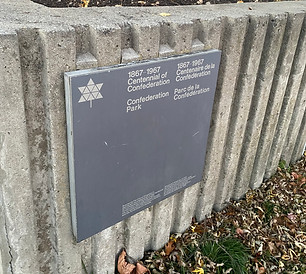Capital Commemoration
Both Kingston locals and visitors are no stranger to the picturesque landscape of Confederation Park. Looking south towards the water, onlookers are greeted by the red roof of Shoal Tower (built in 1846) and the imposing National Historic Site and military fortification, Fort Henry (built between 1832-1840).[1] Market Battery, built in 1846 along with Shoal Tower and the remainder of Kingston’s Martello Towers, protect the park from military invasions and threats that may interrupt the integrity and steadfastness of the country’s first capital. Most importantly, however, is that these colonial military fortifications protect the grandiose spectacle that has become iconic for Kingston – its City Hall. Made of Limestone and constructed in 1844 by George Browne, City Hall has become known for its distinct function as both a political centre, marketplace, as well as shops and other services. In the mid-nineteenth century, City Hall was truly a symbol of prosperity and economic stability – a place on the brink of uniting colonies to become one nation.
Today, Kingston’s City Hall echoes the same narrative of prosperity and economic well-being. Locals and out-of-towners can be found navigating their way through the park and around City Hall, in all its monumental glory, visiting markets and gazing over the Lake. Although only mere remnants of Market Battery remain, groups of people still sit along the wall’s limestone edges. Although some of the sentiments and values projected by this landscape are true to the city, both Confederation Basin and City Hall tell a very one-dimensional, colonial history. Their presence along the waterfront suggests that Kingston’s livelihood and development exists only post-1800, in a settler world of British expansion.
In a high-traffic tourist location, it comes as no surprise that these common narratives are upheld and even revered, even in a post-Truth and Reconciliation political climate. Derek Alderman writes that “as part of a multi-million-dollar heritage tourism industry, these memorials are often tailored to accommodate a broad range of interests.”[2] According to Statistics Canada and Visit Kingston, a local tourism company based in the city, Kingston’s tourism industry is in fact a multi-million-dollar industry.[3] To effectively cater to multiple audiences, Kingston benefits from highlighting the narratives that a majority of visitors and locals are most aware – of Kingston’s colonial roots and status as one of the earliest settlements in British Canada. The continual circulation of this narrative throughout each tourist season provides an excellent platform for which settler colonial narratives can be upheld. Unchangeable due to the City’s reliance on visitor income, the deep-rooted colonial narrative seems almost permanent – and virtually unchangeable – in the city’s Confederation Park and City Hall area.
Settler colonial perspectives are not only maintained, but so too is settler memory formed. As Rick Crownshaw acknowledges, “artifacts are left to speak for themselves.”[4] Even without the presence of a guide, or without a basic understanding of Kingston’s history, the Confederation Park landscape paints a very colonial picture. As explored previously, the landscapes of military forts, the open water and City Hall demonstrate that Kington is a town whose roots are deeply tied to colonial trade, military power and British-Canadian identity.
Works Cited
[1]“Fort Henry National Historic Site of Canada.” Parks Canada. Accessed April 28, 2022. https://www.pc.gc.ca/apps/dfhd/page_nhs_eng.aspx?id=393#:~:text=Construction%20of%20Fort%20Henry%20by,and%20then%20by%20Canadian%20forces
[2] Derek Alderman, Civil Rights Memorials, and the Geography of Memory. (Chicago: Center for American Places at the Columbia College Chicago, 2008): 12.
[3] “The Impact of Tourism in Kingston.” VisitKingston.ca | Fresh Made Daily. Accessed April 28, 2022. https://www.visitkingston.ca/about-tourism-kingston/the-impact-of-tourism-in-kingston/
[4] Rick Crownshaw, “Introduction,” The Future of Memory. (New York, NY: Berghahn Books, Incorporated, 2010), 4.




Shoal Tower, and Fountain at Confederation Park. Photo taken by Sam Nicholls, 2020.
Kingston City Hall. Photo taken by Sam Nicholls, 2020.
Plaque commemorating the Centennial of Confederation, located at Confederation Park, Kingston Ontario.
Photo taken by Sam Nicholls, 2020.
What remains of Market Battery, built in 1846.
Photo taken by Sam Nicholls, 2020.